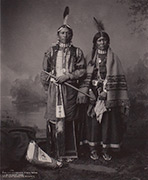The American West: Myth vs Reality
Lesson created by: Jill Foulis
Grade Level: 11 - US History II
Images
5-B N. C. Wyeth, Last of the Mohicans, cover illustration, 1919

N. C. Wyeth (1882–1945). Last of the Mohicans, cover illustration, 1919. Oil on canvas. Collection of the Brandywine River Museum. Anonymous gift, 1981.Reprinted with the permission of Atheneum Books for Young Readers, an imprint of Simon & Schuster Children's Publishing Division from Last of the Mohicans by James Fenimore Cooper, illustrated by N.C. Wyeth. Illustrations © 1919 Charles Scribner's Sons; copyright renewed 1947 Carolyn B. Wyeth.
|
John K. Rose, Benjamin S. Hopkins, Jui, And His Squaw Tan-Nah, 1899

John K. Rose, Benjamin S. Hopkins, Jui, And His Squaw Tan-Nah, 1899. vintage platinum print
Sheet: 9 15/16 in x 7 15/16 in; #AC 2004.160, Mead Art Museum at Amherst College
|
Objectives
- Students will understand that what we think we know about Native Americans in the late 19th century isn't always truly representative of what happened.
Focusing Statement
By examining the 2 pieces of art listed above, what impressions are given by the artists about Native Americans and their culture? What questions do these paintings leave us with regarding Native Americans?
Examining Expressive Content
- Describe what you see.
- What do you notice first?
- How are people shown?
- Describe the setting.
- Are there words to help you decipher the painting? If not, what other cues from the painting can you use to assist you?
- Is there anything that you don't understand or can't explain?
- Is there something you didn't notice initially but notice now?
Prior to the lesson
- Students will examine pivotal events for Native Americans with emphasis on the second half of the 19th century.
- They will have been exposed to some aspects of Native Americans: their treatment by white settlers during colonial contact, policies of Washington and Jefferson, Tecumseh, and finally Jackson's Indian Removal Policy and Trail of Tears.
- Students will examine the reservation and assimilation policies of the US government with focus on the later half of the 19th century. Indian schools will be of particular interest in our discussion of loss of Native American identity. Photos and journal entries will be used here.
- They will use textbook as well as their supplemental reading text for content and background information.
- Students will research Native American culture from this time period using primary source documents. They are encouraged to use documents from the Library of Congress American Memory Collection.
- Additional resources will include viewing segments of Ken Burns The West video series as well as some 1930 and 1940s westerns depicting Native Americans in early Hollywood movies. (re: She Wore a Yellow Ribbon, Stagecoach. Could even use clips of Dances With Wolves to see a contemporary Hollywood example of Native Americans)
Teaching Plan
- Students will find a work of art or photograph depicting Native Americans. Students will write an essay using their work of art/photograph to answer what is the myth vs reality of the depiction of Native American culture.
- Students will display work and present orally on it addressing this myth vs. reality question.
- As a class, we will review the artwork and make generalizations about Native American portrayals and whether or not this is an accurate depiction of Native peoples, keeping in mind the time period when the work was created, purpose of the work, and artist background.
Putting It All Together
After the class presentations and discussion, we will examine the original 2 works of art presented at the beginning of the lesson. Do students view the works in a different light? Are there other works presented by students that are similar in nature? Are there other works presented by students that are different in the depiction of Native Americans? How does the background of the artist, the purpose of the painting/photograph, and the time in which a work is created affect how the work should be viewed? Is that information important to the works we have examined in this project? Why? What happens when that information is missing? What misconceptions are likely to occur? How do these misconceptions perpetuate the myth vs reality of Native Americans, or any group for that matter?
Standards
Massachusetts History and Social Science Standards
- USII.4 Analyze the causes of the continuing westward expansion of the American people after the Civil War and the impact of this migration on the Indians. (H)
Common Core Standards
English Language Arts Standards » History/Social Studies » Grade 11-12
CCSS.ELA-Literacy.RH.11-12.2 Determine the central ideas or information of a primary or secondary source; provide an accurate summary that makes clear the relationships among the key details and ideas.
CCSS.ELA-Literacy.RH.11-12.7 Integrate and evaluate multiple sources of information presented in diverse formats and media (e.g., visually, quantitatively, as well as in words) in order to address a question or solve a problem.
CCSS.ELA-Literacy.RH.11-12.9 Integrate information from diverse sources, both primary and secondary, into a coherent understanding of an idea or event, noting discrepancies among sources.
|






